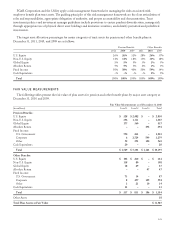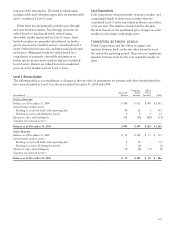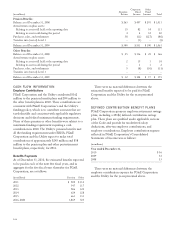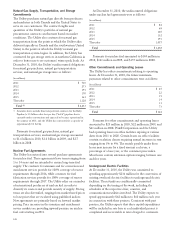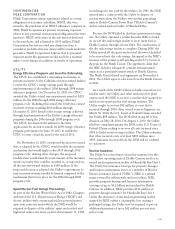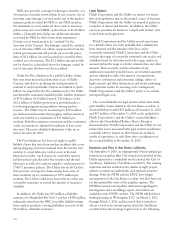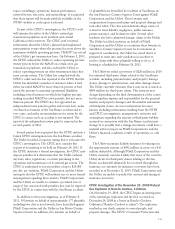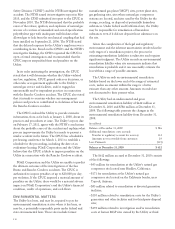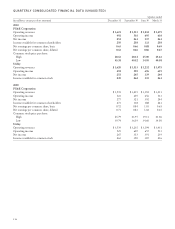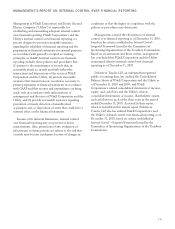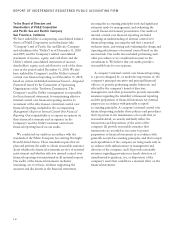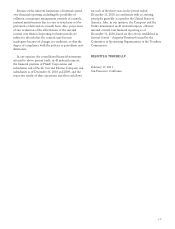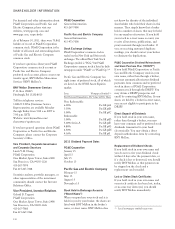PG&E 2010 Annual Report Download - page 114
Download and view the complete annual report
Please find page 114 of the 2010 PG&E annual report below. You can navigate through the pages in the report by either clicking on the pages listed below, or by using the keyword search tool below to find specific information within the annual report.NEIL also provides coverage for damages caused by acts
of terrorism at nuclear power plants. If one or more acts of
terrorism cause damages covered under any of the nuclear
insurance policies issued by NEIL to any NEIL member,
the maximum recovery under all those nuclear insurance
policies may not exceed NEIL’s policy limit of $3.2 billion
within a 12-month period plus any additional amounts
recovered by NEIL for these losses from reinsurance.
Certain acts of terrorism may be “certified” by the
Secretary of the Treasury. For damages caused by certified
acts of terrorism, NEIL can obtain compensation from the
federal government and will provide up to its full policy
limit of $3.2 billion for each insured loss caused by these
certified acts of terrorism. The $3.2 billion amount would
not be shared as is described above for damages caused by
acts of terrorism that have not been certified.
Under the Price-Anderson Act, public liability claims
that arise from nuclear incidents that occur at Diablo
Canyon, and that occur during the transportation of
material to and from Diablo Canyon are limited to $12.6
billion. As required by the Price-Anderson Act, the Utility
purchased the maximum available public liability insurance
of $375 million for Diablo Canyon. The balance of the
$12.6 billion of liability protection is provided under a
loss-sharing program among utilities owning nuclear
reactors. The Utility may be assessed up to $235 million
per nuclear incident under this program, with payments in
each year limited to a maximum of $35 million per
incident. Both the maximum assessment and the maximum
yearly assessment are adjusted for inflation at least every
five years. The next scheduled adjustment is due on or
before October 29, 2013.
The Price-Anderson Act does not apply to public
liability claims that arise from nuclear incidents that occur
during shipping of nuclear material from the nuclear fuel
enricher to a fuel fabricator or that occur at the fuel
fabricator’s facility. Such claims are covered by nuclear
liability policies purchased by the enricher and the fuel
fabricator as well as by separate supplier’s and transporter’s
(“S&T”) insurance policies. The Utility has an S&T policy
that provides coverage for claims arising from some of
these incidents up to a maximum of $375 million per
incident. The Utility could incur losses that are either not
covered by insurance or exceed the amount of insurance
available.
In addition, the Utility has $53 million of liability
insurance for Humboldt Bay Unit 3 and has a $500 million
indemnification from the NRC for public liability arising
from nuclear incidents, covering liabilities in excess of the
$53 million of liability insurance.
Legal Matters
PG&E Corporation and the Utility are subject to various
laws and regulations and, in the normal course of business,
PG&E Corporation and the Utility are named as parties in
a number of claims and lawsuits. In addition, the Utility
can incur penalties for failure to comply with federal, state,
or local laws and regulations.
PG&E Corporation and the Utility record a provision
for a liability when it is both probable that a liability has
been incurred and the amount of the loss can be
reasonably estimated. PG&E Corporation and the Utility
evaluate the range of reasonably estimated costs and record
a liability based on the lower end of the range, unless an
amount within the range is a better estimate than any other
amount. These accruals, and the estimates of any
additional reasonably possible losses, are reviewed quarterly
and are adjusted to reflect the impacts of negotiations,
discovery, settlements and payments, rulings, advice of
legal counsel, and other information and events pertaining
to a particular matter. In assessing such contingencies,
PG&E Corporation’s and the Utility’s policy is to exclude
anticipated legal costs.
The accrued liability for legal matters (other than third-
party liability claims related to the San Bruno accident, as
discussed below) totaled $55 million at December 31, 2010
and $57 million at December 31, 2009 and is included in
PG&E Corporation’s and the Utility’s current liabilities –
other in the Consolidated Balance Sheets. Except as
discussed below, PG&E Corporation and the Utility do not
believe that losses associated with legal matters would have
a material adverse impact on their financial condition,
results of operations, or cash flows after consideration of
the accrued liability at December 31, 2010.
ExplosionandFires inSanBruno, California
On September 9, 2010, an underground 30-inch natural gas
transmission pipeline (line 132) owned and operated by the
Utility ruptured in a residential area located in the City of
San Bruno, California (“San Bruno accident”). The ensuing
explosion and fire resulted in the deaths of eight people,
injuries to numerous individuals, and extensive property
damage. Both the NTSB and the CPUC have begun
investigations of the San Bruno accident, but they have not
yet determined the cause of the pipeline rupture. The
NTSB has issued several public statements regarding the
investigation and a metallurgy report, all of which are
available on the NTSB’s website. The NTSB will hold fact-
finding hearings in Washington, D.C. on March 1, 2011
through March 3, 2011 and has stated that it intends to
release a total of six factual reports about the San Bruno
accident before the hearings begin based on the following
110



